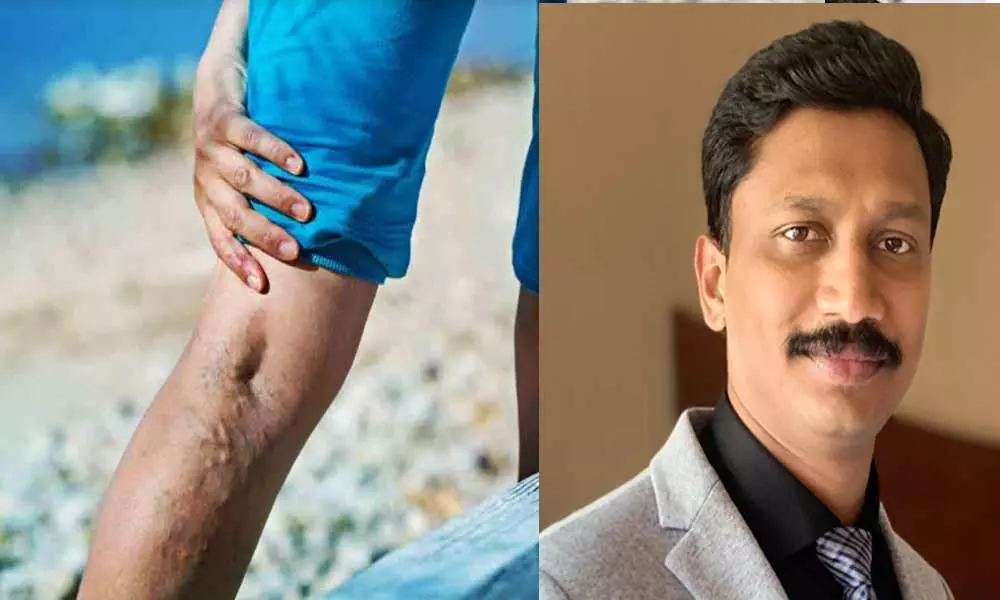Live
- Former Prime Minister Manmohan Singh Dies at 92: A Legacy of Economic Reforms
- Nagesh Trophy: Telangana, Gujarat dominate action on Day 4 with easy wins
- Get Ready for Dreame Technology’s Year-End Amazon Sale – Big Savings on Smart Home Products
- FIR registered as 4 voter forgery cases come to light in Delhi's Okhla constituency
- Ayodhya Ram temple to host majestic anniversary celebrations on Jan 11 with devotional, cultural programmes
- National Policy Framework on Agricultural Marketing draft silent on MSP: Punjab
- Thyrocare Sets Benchmark as The First National Diagnostic Chain with 100% of its Labs with NABL Accreditation
- Hisense India Partners with Reliance resQto Elevate After-Sales Service Nationwide
- RG Kar tragedy: CFSL reports suggest further probe to find whether rape & murder committed by only one or others involved
- PM Modi takes stock of 8 big infra projects worth Rs 1 lakh crore
Just In
Preventing Deep Vein Thrombosis – A guide towards healthy living


Preventing Deep Vein Thrombosis – A guide towards healthy living
Blood clotting is an important biological process that obstructs excessive blood loss in case of an injury. The clot itself is supposed to dissolve after cure.
Blood clotting is an important biological process that obstructs excessive blood loss in case of an injury. The clot itself is supposed to dissolve after cure. However, in some cases, the clot is unable to dissolve naturally and in a few of those cases, they also get formed in veins of various parts of the body. This condition is known as thrombosis.
Understanding Deep Vein Thrombosis (DVT)
Blood clots can develop in any place of the body – legs, shoulders, heart and sometimes, even the brain. Sometimes, these clots are developed in the deep veins inside our body which are located deep under our skin. When these clots form in those deep veins, the condition is known as Deep Vein Thrombosis (DVT). Symptoms might not show up in every case. But symptoms which can be recognized include swelling, pain, and tenderness, often in the legs.
In certain cases, these clots can be dangerous when they get separated from the veins in one's legs and move to other parts of the body like lungs via the circulatory system. Deep Vein Thrombosis can be life-threatening in such cases when the insoluble clot has moved from one leg into the lung, called, Pulmonary Embolism, in which broken clot blocks the artery in the lung, and cuts off the blood supply to the heart.
There are three important factors that can lead to clot formation namely, restricted or limited physical movement, damaged blood vessels (possibly caused by certain surgeries or pressure in the blood vessels) and disturbance in the pattern of the blood flow, which leads to stagnation of blood in the arteries or veins leading to formation of clots.
Commenting on the prevalence of DVT in India, Dr. Narendranadh Meda, Chief Consultant Vascular & Endovascular Surgeon Foot Care Specialist, KIMS Hospitals, Hyderabad, said that the link between cancer and deep vein thrombosis (DVT) is a two-way street. The risk of DVT increases up to 4-7-fold in cancer patients. Some types of cancer are more likely to cause DVT than others, such as cancers of the brain, liver, ovarian, lung, pancreas, stomach, uterus, leukemia, and lymphoma. It is also possible that a clot can be an early sign of cancer. However, treatment of cancer can also cause blood clots. One must thus keep in mind that; Chemotherapy is often a lifesaving part of cancer treatment, but some chemo drugs also raise the chances of formation of blood clots. These medicines may damage blood vessels or lower the level of special proteins in blood that stop clotting. If the idea that treatment could cause a DVT worries you, keep in mind that your doctor will carefully weigh the pros and cons before they suggest you get chemo.
Treatment and Prevention
Most cases of DVT can be treated with medicines. These medicines generally help in preventing formation of new clots.However, in rare cases where medicines are simply not enough, patients must be treated with Endovascular Treatment (Thrombolysis).
Dr Narendranadh said: "There are three main goals to reduce risk of DVT, namely, to help prevent the clot from getting bigger, prevent the clot from breaking loose and traveling to the lungs and in general reduce your chances of suffering from another stint of DVT. DVT is mostly treated with anticoagulants, also known as blood thinners. These drugs don't break up existing blood clots, but they can prevent clots from getting bigger and reduce your risk of developing more clots. In few cases where patients have got severe symptoms with massive leg swelling, the doctor needs to do Pharmaco-Mechanical Thrombolysis (They use Special device to break the clot and injection to dissolve the clot). With this, patient will feel immediate symptomatic relief (Leg swelling& pain) after the procedure".
A wearable medical fabric called Compression Stockings reduce the chances ofthe blood to pool and clot. To help prevent swelling associated with deep vein thrombosis, wearing this fabric from feet to about the level of your knees during the day for at least two years.
Once you receive treatment for DVT, it is important to follow some lifestyle changes to manage condition and prevent another blood clot.
Lifestyle changes include:
1) Consumption of foods high in vitamin K, such as spinach, kale, other leafy greens, and Brussels sprouts, can interfere with one of the anti-coagulants known as warfarin and thus must be avoided.
2) Compulsorily take medications as directed.
3) Perform regular exercise. It can help to maintain a healthy weight, reduce your risk of disease and is good for your veins as well. Exercise promotes healthy circulation and blood flow.

© 2024 Hyderabad Media House Limited/The Hans India. All rights reserved. Powered by hocalwire.com






